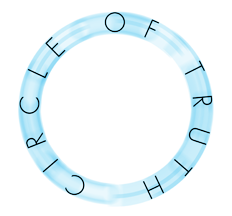Doro Hofmann Essay
#14 Ron Griffin (Visiting Painting)
#15 Doro Hofmann (Response Painting)
I was excited and curious about the canvases coming to my studio. It was only after they arrived that I started to feel pressure, and that I had welcomed an intruder into my studio, my private place. In front of me stood this matte black square, with an airmail envelope placed right in the middle, clearly transporting a piece of art, a postcard within the somewhat transparent envelope revealing something that looked like either a cubistic sculpture or painting. The previous artist had decided to display this envelope open, showing the side on which you write the address and put the stamp. The work felt very dark, matte black being its main color. I work in shades of bright, diverse colors and textures. I felt the urge to give my piece more freshness as a new start for the next artist, with a somewhat reduced color palette.
The painting implied movement to me, a forward drive of culture, art and poetry. As I am interested in Pop Art, I chose Roy Lichtenstein’s brush strokes to depict motion. I distorted the strokes in an exaggerated perspective. My background would be an open ocean and sky, tilted as we glide over it. Such a landscape and its underlying energy flow, portray that particular moment in artmaking – the flash of inspiration, the ecstatic, triggering a feeling of power, freedom, truth. To translate the power of poetry and the word, I chose the words of the German dramatist, poet, writer and director, Heiner Müller. The words were printed with silver pigment referring to the silver lining meaning of the same:
Das einzigste was ein Kunstwerk kann,
ist Sehnsucht zu wecken
nach einem anderen Zustand der Welt.
Und diese Sehnsucht ist revolutionär.
~ Heiner Müller, Gesammelte Irrtümer, 1983
Which translates in English to:
A work of art can do no more
than awaken a longing
for the world to be in a different state.
And that longing is revolutionary.
I’m not sure if these words are as powerful in English. In German they are highly meaningful, considering Müller’s enduring difficulties and censorship, living in the GDR. I find them apropos describing what art is capable of. But at the same time, these words are deprived of their meaning by adding them into a collection misunderstandings. I expect the outcome of the Circle of Truth will likely be this – a collection of misunderstandings along the process of their creation, nevertheless a collection of great artwork and the result of an exciting and curious experience.



